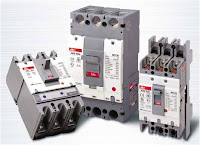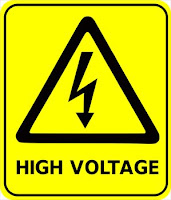is a liquid / solid / gas material that can conduct electricity easily.Good conductor is one that has a smaller resistivity. In general, the metal is conductive. Gold, silver, copper, aluminum, zinc, iron successive having resistivity greater. So as gold is a very good conductor, but because it is very expensive, the economic copper and aluminum are the most widely used.
Definition conductor or conductor understanding. Conductor or conductor is a substance or material which is able to deliver energy, both electrical energy and heat energy, either solid, liquid or gas. The materials that are conductors is normally used to make tools that are needed energy transfer, such as pans, irons, cable and solder.
1.1 Type Conductor Materials
The materials used for conductors must meet the following requirements:
1. Conductivity is quite good.
2. Mechanical strength (tensile strength) is quite high.
3. Length expansion coefficient is small.
4. Elastic modulus (modulus of elasticity) is quite large.
The materials used as conductors, among others:
1. Common metals, such as copper, aluminum, iron, and so on.
2. Alloy (alloy), which is a metal of copper or aluminum that were mixed in a certain amount of other types of metal, which is useful to increase mechanical strength.
3. Metal alloys (composite), ie two or more metals are combined by means of compression, fusion (smelting) or welding (welding).
1.2 Classification of conductors
1.2.1 Classification of conductors according to the material:
1. ordinary metal wire, for example:
a. BBC (Bare Copper Conductor).
b. AAC (All Aluminum Alloy Conductor).
2. wire alloys (Alloy), for example:
a. AAAC (All Aluminum Alloy Conductor)
b. alloy wire (composite), such as: copper coated steel wire (Copper Clad Steel) and steel wire coated aluminum (Aluminum Clad Steel).
3. wire wrap mixture, ie the wire windings consist of two or more metals,
example: ASCR (Aluminum Cable Steel Reinforced).
1.2.2 Classification of conductors by construction:
1. solid wire (solid wire) Berpenampang round.
2. berlilit wire (standard wire) comprising 7 to 61 solid wire, wound into one, usually layered and concentric.
3. hollow wire (hollow conductor) is a hollow wire is set to get a huge line outside the center.
1.2.3. Classification of conductors according to its physical form:
1. bare conductors.
2. insulated conductor, a conductor on the outside naked and isolated in accordance with the allotment of work stress, for example:
a. Twisted wires.
b. Cable NYY
c. Cable NYCY
d. Cable NYFGBY
1.3 Characteristics Conductor
There are 2 (two) types of conductor characteristics, namely:
1. mechanical characteristics, which indicate the physical state of the conductor which states the tensile strength of the conductor (from SPLN 41-8:1981, for 70 mm sheathed conductors AAAC-S at a temperature of about 30 C, the maximum capacity of the conductor is to deliver current 275 A).
2. electrical characteristics, which shows the ability of the conductor to the electric current passing through it (from SPLN 41-10: 1991, to 70 mm2 sheathed conductors AAAC-S at a temperature of about 30o C, the maximum capacity of the conductor to deliver current is 275 A).
1.3.1 Electrical Conductivity
Electrical conductivity properties of the material represented by the conductivity, which is the inverse of resistivity or resistivity conductor, where the conductor resistivity is defined as:
R. A
ρ = ----------
l
where;
A: cross-sectional area (m2)
l: length of conductor (m)
Ώ: Conductor resistivity (ohm.m)
R: Conductor resistance (ohms)
ρ: conductivity
1
a = ------
ρ
Stating ease - ease of a material to carry electrical current. Unit of conductivity is (ohm meter). Conductivity is the electrical properties required in various applications as a conductor of electricity and has a very wide price range. Metals or materials that are good electrical conductor, electrical conductivity of the order of 107 (ohm.meter) -1 and vice versa insulator material has a very low conductivity, which is between 10-10 up to 10-20 (ohm.m) -1 . Between these two extreme properties, there is a semi-conductor material conductivity ranging from 10-6 to 10-4 (ohm.m) -1. In contrast to the low voltage cables, medium voltage cables for the fulfillment of the function of the conductor and the safety of the use of, or the third type conductivity properties used above all.
-------------------------------------------------- ----------------------------------------
Silver (Ag) ............................ 6.8 x 107
Copper (Cu) ....................... 6.0 x 107
Gold (Au) .......................... .. 4.3 x 107
Aluminum (Ac) ................... .. 3.8 x 107
Brass (70% Cu - 30% Zn) ... 1.6 x 107
Iron (Fe) .............................. 1.0 x 107
Carbon steel (FFE - C) ............. 0.6 x 107
Stainless steel (FFE - Cr) ...... 0.2 x 107
Table 1. Electrical conductivity of various metals and alloys At Room Temperature.
1.3.2 Criteria for quality conductor
Conductive metallic conductivity is strongly influenced by the elements - alloying elements, major impurity or crystal imperfections in the metal, which is the third of a role in the process of manufacture of the conductor itself. Element - the element of the tour besides affecting the electrical conductivity, it will affect the properties - mechanical and other physical properties. Pure metal has better electrical conductivity than the lower purity. However, the mechanical strength of pure metal is low.
Conductor of electricity, in addition to requiring high conductivity also requires certain physical and mechanical properties that are tailored to the use of the conductor itself.
In addition to technical problems, the use of metal as a conductor was also largely determined by the economic value of the metal community. Thus a compromise between technical and economic value of metal to be used absolute attention. Termurahlah compromise value that will determine which metal will be used. At this time, Metal Copper and Aluminum is a metal that was selected among other types of metal conductors that meet the technical compromises cheapest economical.
Of the types of metal conductors in Table 1. above, copper is a conductor of the longest used in the field of electricity. In 1913, by the International Electrochemical Commission (IEC) set a standard that indicates conductivity copper wire which was then known as the International Annealed Copper Standard (IACS). The standard states that for copper wire that has been softened by annealing process (annealing), has a length of 1m and 1mm2 cross sectional area, and have the electrical resistivity (resistance) is not more than 0.017241 ohms at a temperature of 20oC, has declared 100% IACS electrical conductivity.
However, with technological advances making process copper achieved, where the level of purity copper conductor wire is much higher than in 1913, the electrical conductivity of copper wire today can reach above 100% IACS.
For Aluminium wire, regular electrical conductivity compared to the standard copper wire. According to standard ASTM B 609 for aluminum wire of the type EC grade or AA series 1350 (*), electrical conductivity ranged from 61.0 - 61.8% IACS, depending on the hardness or temper. As for the conductor wire of aluminum alloy AA 6201 series, according to standard ASTM B 3988 persaratan electrical conductivity can not be less than 52.5% IACS. 6201 Conductor Wire is usually used for the type of cable materials All Aluminium Alloy Conductor (AAAC).
In addition to the requirements of the electrical properties such as electrical conductivity above, other quality criteria must also be met include all or part of nature - the nature or conditions of the following, namely:
a. chemical composition.
b. tensile properties such as tensile strength (tensile strength) and tensile strain (elongation).
c. bending properties.
d. diameter and the allowable variation.
e. surface condition of the wire must be free from defects, and others.
















